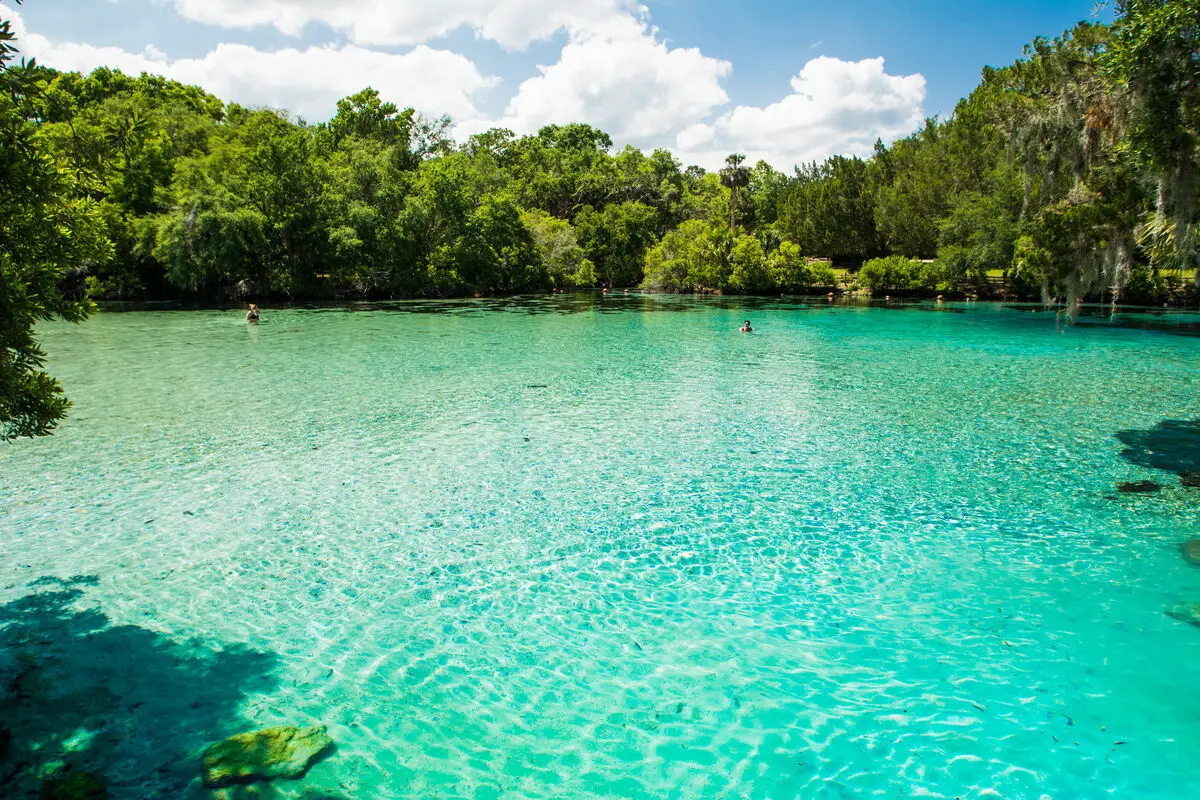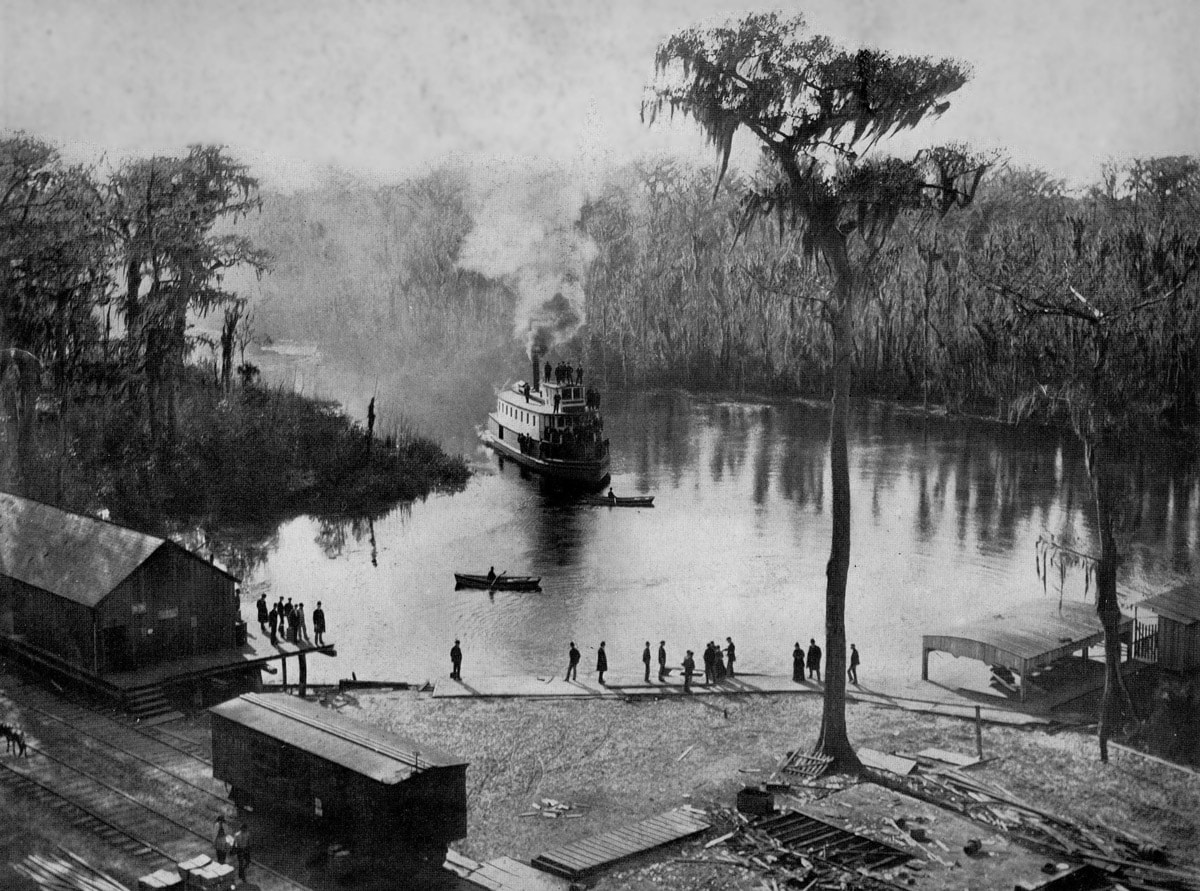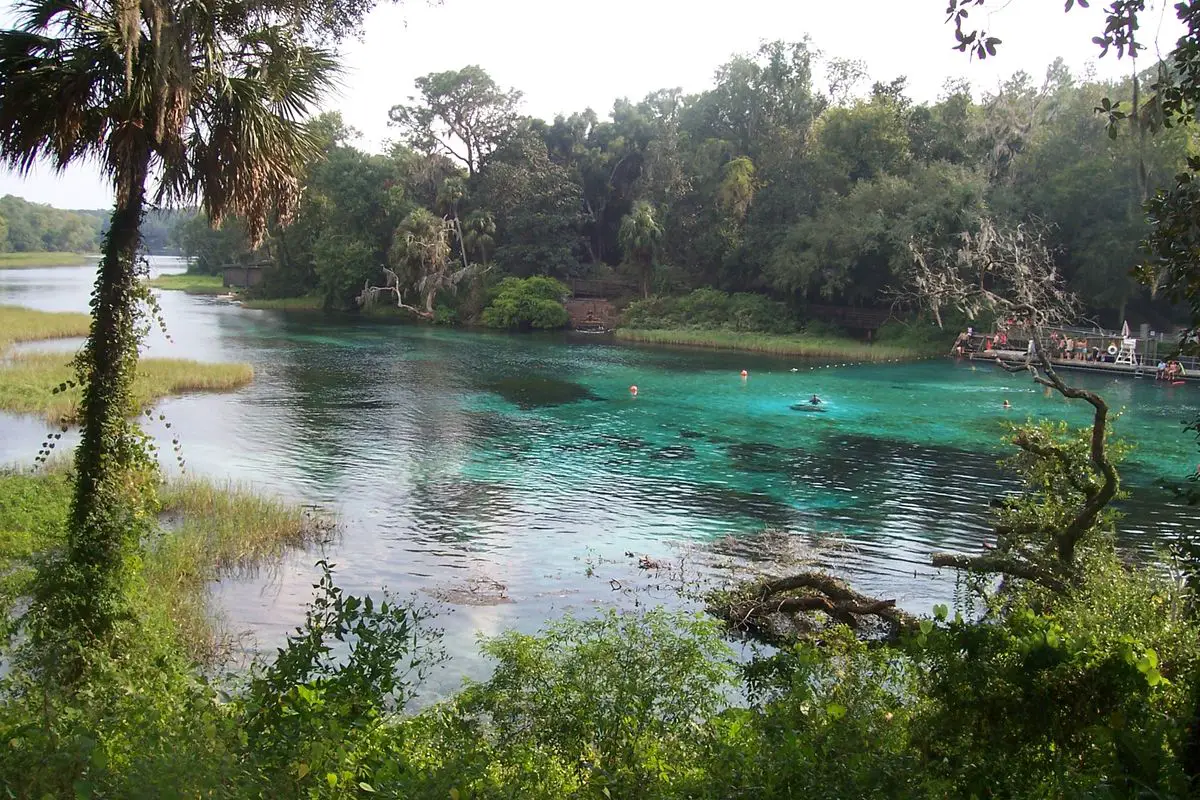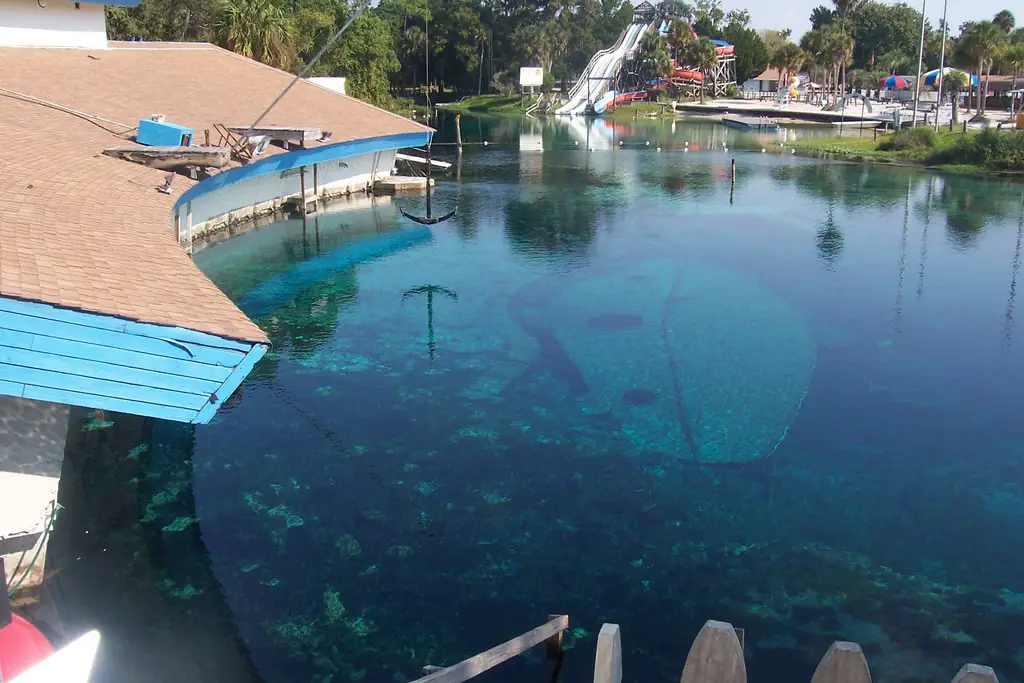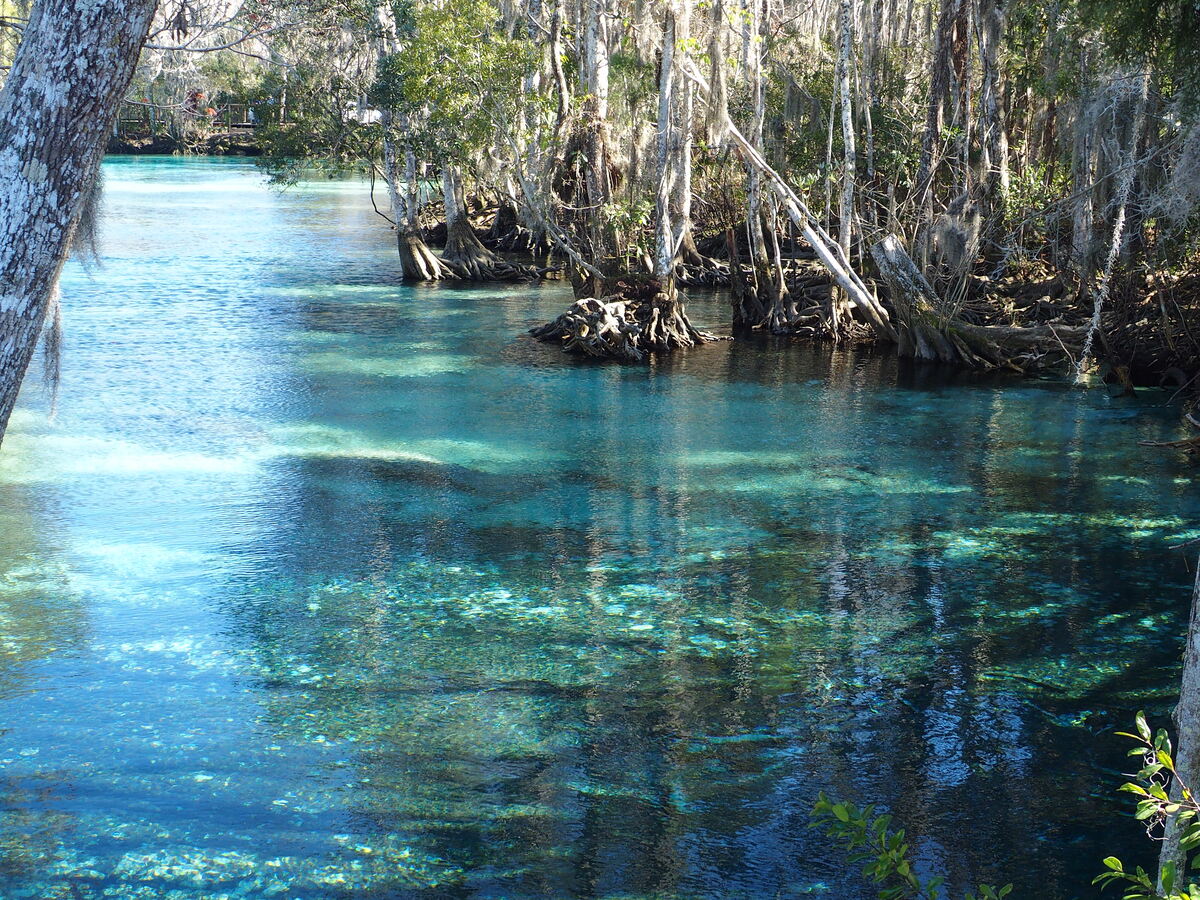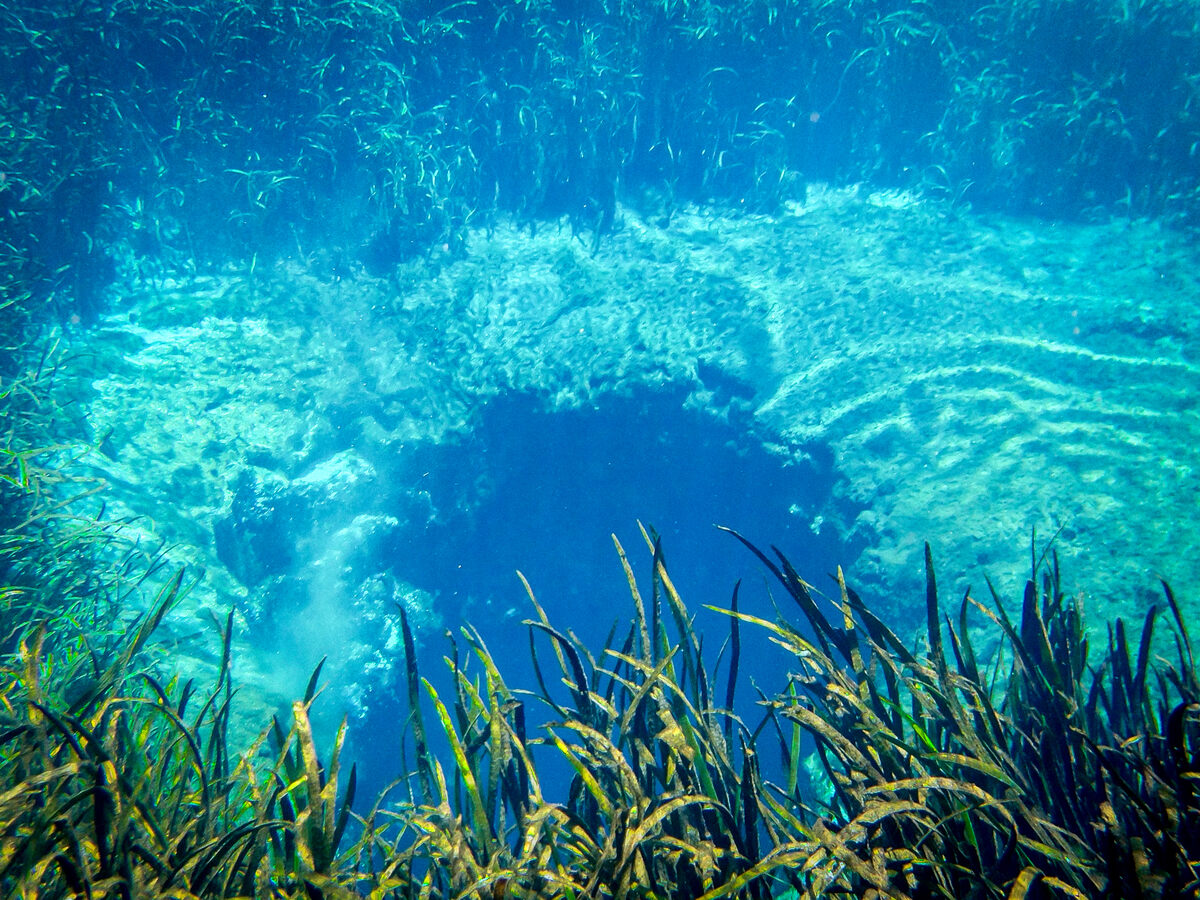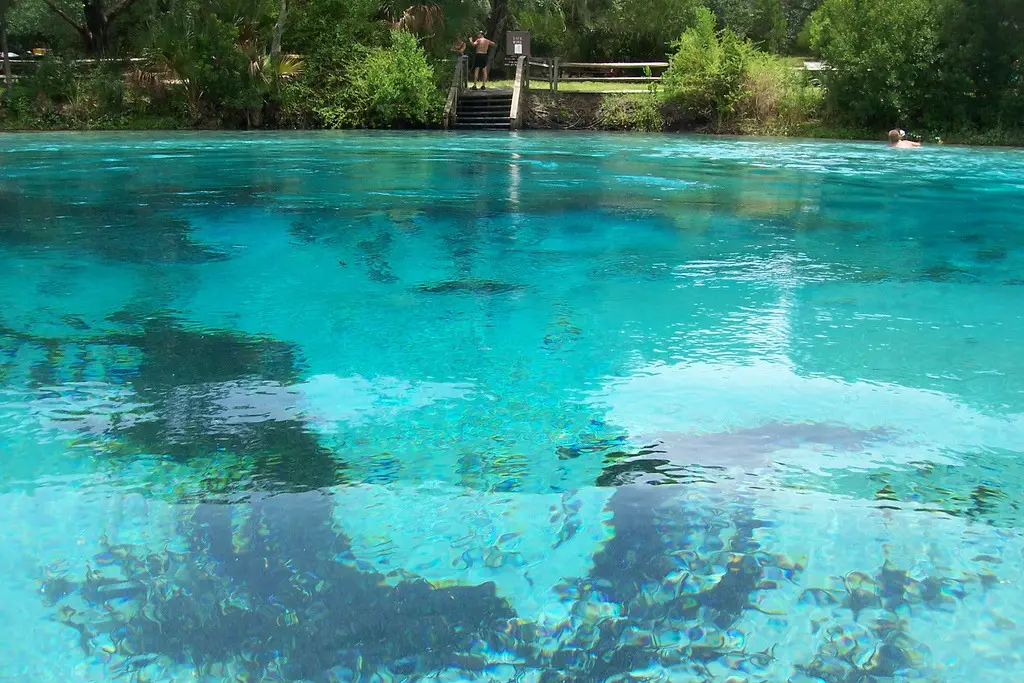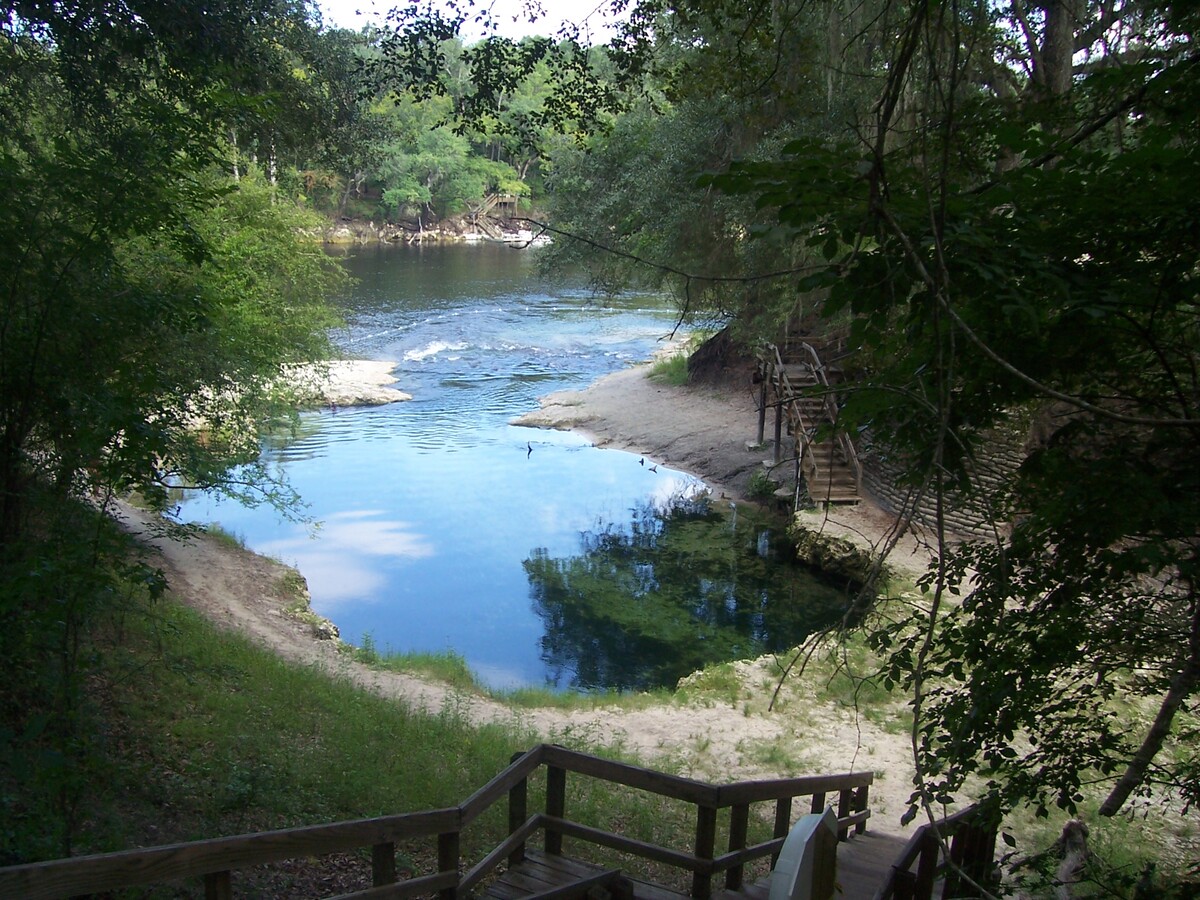Wondermondo 🢖 Lists and articles 🢖 First magnitude springs in Florida
Publication
First magnitude springs in Florida
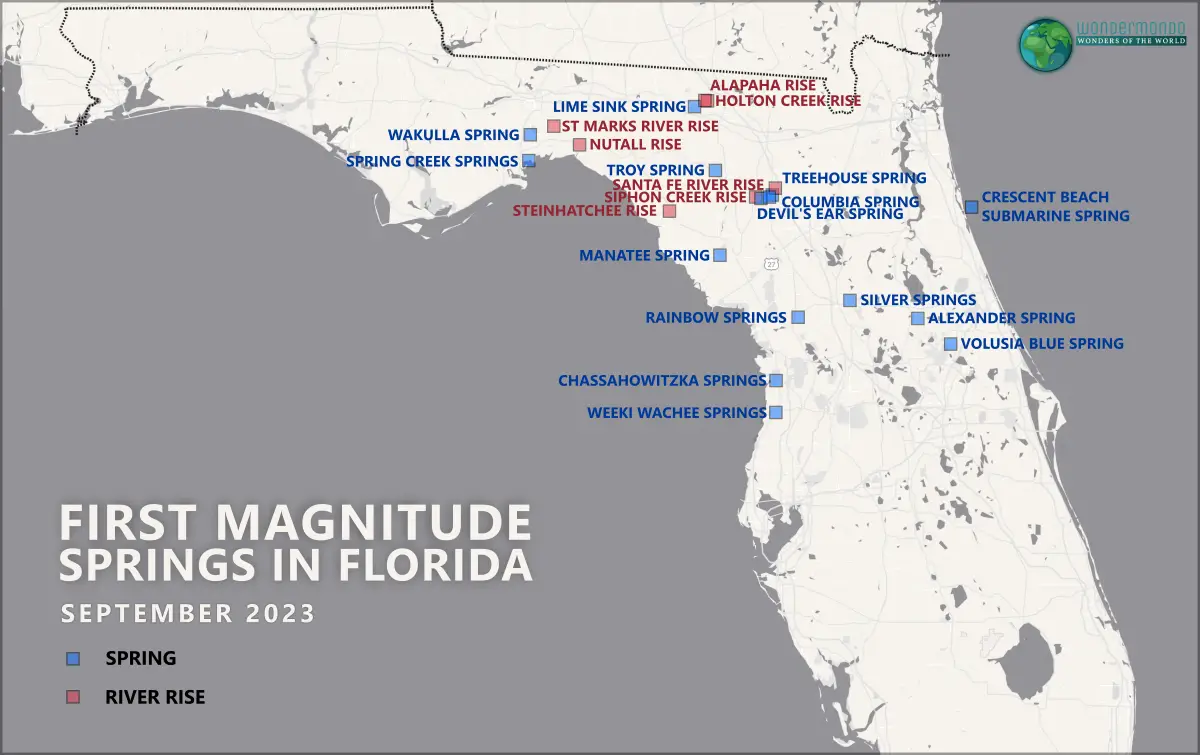
 In short
In short
Unique landmarks of Florida are its magnificent, powerful springs. In this article are reviewed the largest of them – first magnitude springs of Florida whose mean discharge exceeds 100 cubic feet (2,832 liters) per second.
Contents
- About the springs in Florida
- List of current (2023) first magnitude springs in Florida
- List of other giant springs in Florida
Map of the first magnitude springs and other great springs of Florida
If you see this after your page is loaded completely, leafletJS files are missing.
 About the springs in Florida
About the springs in Florida
Floridan Aquifer – source of giant springs
In the southern parts of South Carolina, Georgia and Alabama, as well as in most of Florida close to the ground surface is limestone that formed in Paleocene and Eocene.
In this area rain is frequent. Limestone is permeable – rainwater “soaks” into its fractures and pores, gradually dissolving the stone and creating passages through it (karst process). Such rainwater from the limestone is clean – it may be rich with lime but does not contain organic substances. It is very clear, with a distinct tint of blue-green color.
As a result, in these limestone layers has formed Floridan Aquifer – an extremely rich source of high quality groundwater.
In the central and northern parts of Florida, where this limestone is close to the ground surface, have formed hundreds of springs, including some of the most powerful springs in the world.
Springs and humans
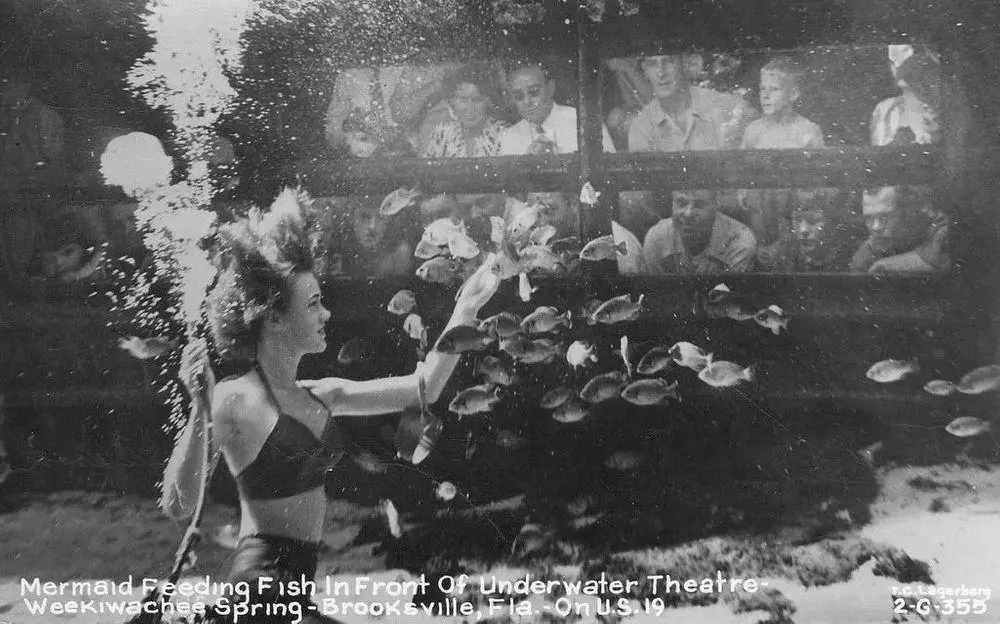
These gargantuan fountains of lucid, blue-green masses of water attracted the attention of humans since the prehistoric times. More than 10 thousand years ago near the springs appeared some of the oldest settlements in this part of America – springs attracted enough fish and shellfish and people did not have to move around in eternal search of food.
Before the opening of Disney theme park the best known tourist attractions in Florida were several springs, such as Weeki Wachee Springs. Resorts were developed around numerous springs of Florida. Many of the great springs are very popular up to this day.
Unfortunately, human activities have left adverse impact on springs of Florida. Water uptake has decreased the flow rate in many springs. Most of the springs have been polluted to some extent. The most widespread is nitrate pollution that has been caused by the use of fertilizers in agriculture. Frequently the springs were degraded also by the recreational activities.
At the same time, there is done a lot to improve the environmental situation. One of the most important measures is the Florida State Rules “Outstanding Florida Springs” that establish specific rules for the groundwater use in areas around 30 most prominent springs.
About the list
The list below is based on a single parameter – the mean discharge of a single spring. If it exceeds 100 cubic feet (2,832 liters) per second – this is a spring of the first magnitude.
This might sound simple, but it is not. There are many pitfalls, such as:
- Many springs are rarely measured. Sometimes this is nearly impossible, for example, if the spring is on the riverbed. Should we really compare a spring that is measured a few times with a spring that has been measured for hundreds of times?
- The time period of measurements is not standardized. Should we take the mean discharge of one spring since the 1930ies and compare it with another one, whose measurements started only in 2000? This can be not fair, as the discharge of springs fluctuates a lot over the time. Thus, Hornsby Spring around 2008-2010 totally stopped to flow. But, in 2015-2023 its mean discharge has been 4 472 l/s – a true 1st magnitude spring!
- Is it one spring or more? Frequently this is hard to tell. Spring may come from a long fissure and in some places in the fissure the flow is weaker, in some – stronger. Is this one spring or numerous? There can be two vents just a few meters from each other – is this a single spring or two?
- Is river resurgence a true spring? In Florida this is a common feature – large rivers can disappear under the ground and then resurface again. This is not a “true” spring with clear, blue-green water – there comes up brownish, tannic river water. Wondermondo has included in this list river resurgences, but these are marked.
- Is karst window a spring? Frequently the ceiling of underground stream collapses and a short section of its stream opens to the outside world. Yes, at one end of it the water comes out as a spring, but at the other end this spring disappears underground again. In the list below are some karst windows, Wondermondo has marked them.
In spite of the above said, there certainly are true first magnitude springs. Currently there are 24 convincing 1st magnitude springs in Florida, but there are several more powerful springs that, upon more measurement and, also, in the case of better environmental policies, might be 1st magnitude springs.
01
Wakulla Spring
 45.3%
45.3%
Artesian spring
17,437 l/s (2004-2009) (1.)
One of the largest springs worldwide and it is also a part of one of the largest underwater cave systems in the world. Water of this spring would be sufficient for the daily needs of some 10 million people.
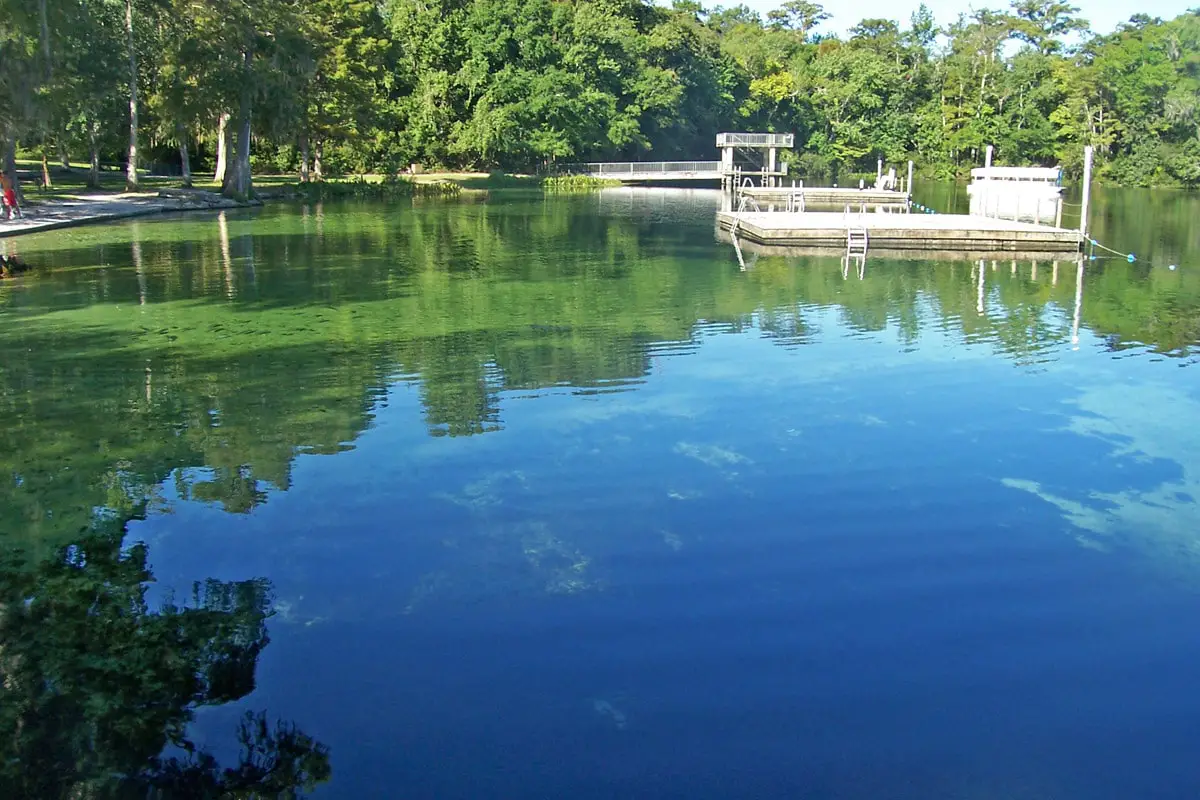
02
Alapaha Rise
 39.8%
39.8%
River rise
16,260 l/s (Oct 2012 – Oct 2016) (2.)
The most powerful river rise in the United States, there rises the nearby river water.
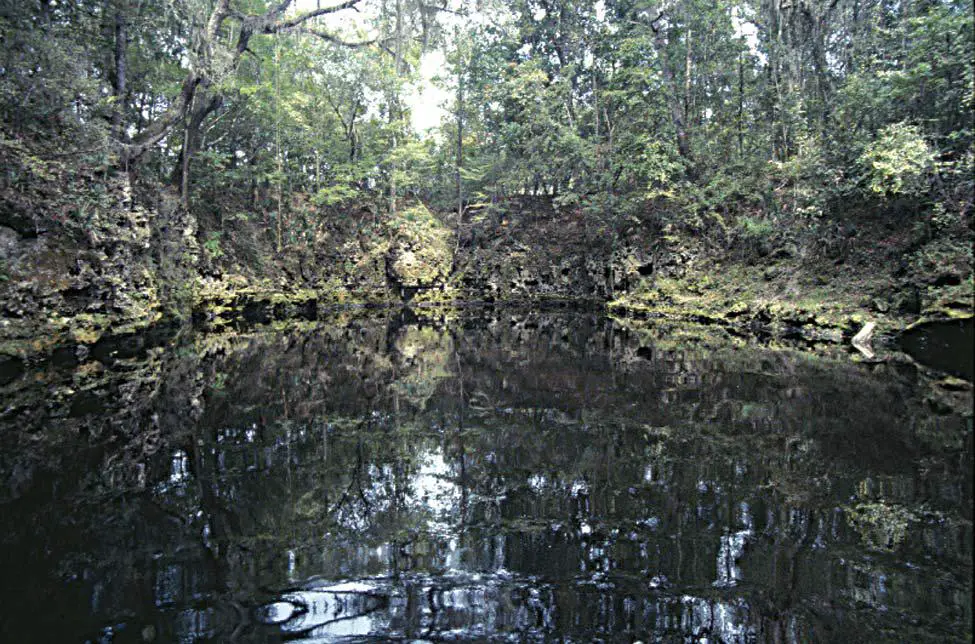
03
Santa Fe River Rise (Santa Fe Rise)
 32.8%
32.8%
River rise
14,511 l/s (1998-2014) (2.)
The largest single spring in the United States, a rise of the nearby river water.
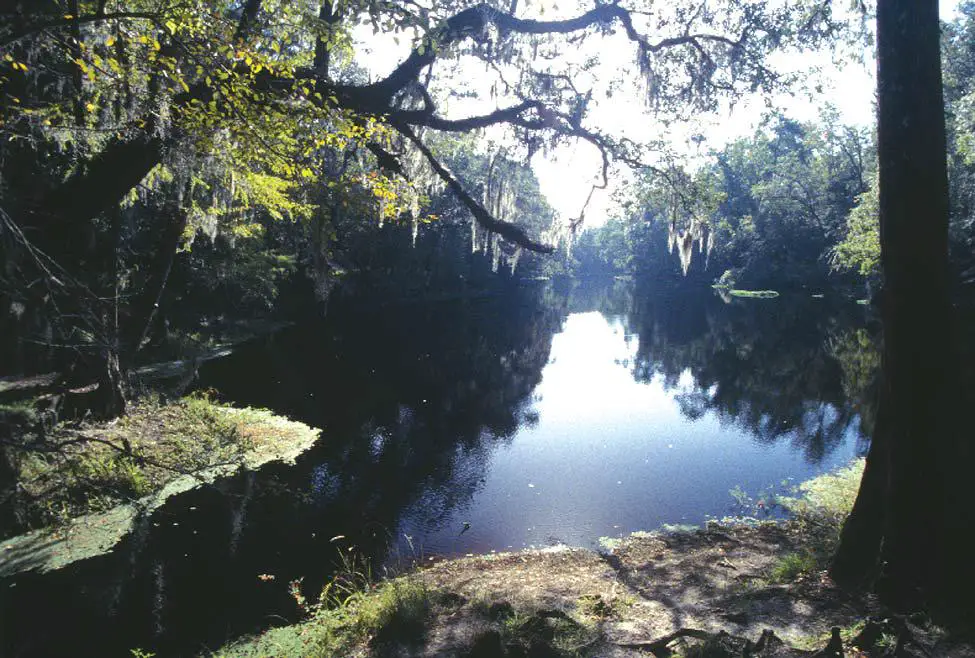
04
St Marks River Rise
 38.8%
38.8%
River rise
12,800 l/s (1956-2017) (3.)
As it is usual with many Floridan rivers, St Marks River sometimes disappears underground to emerge on the surface shortly after. The last such rise before entering into the Gulf of Mexico is St Marks River Rise.
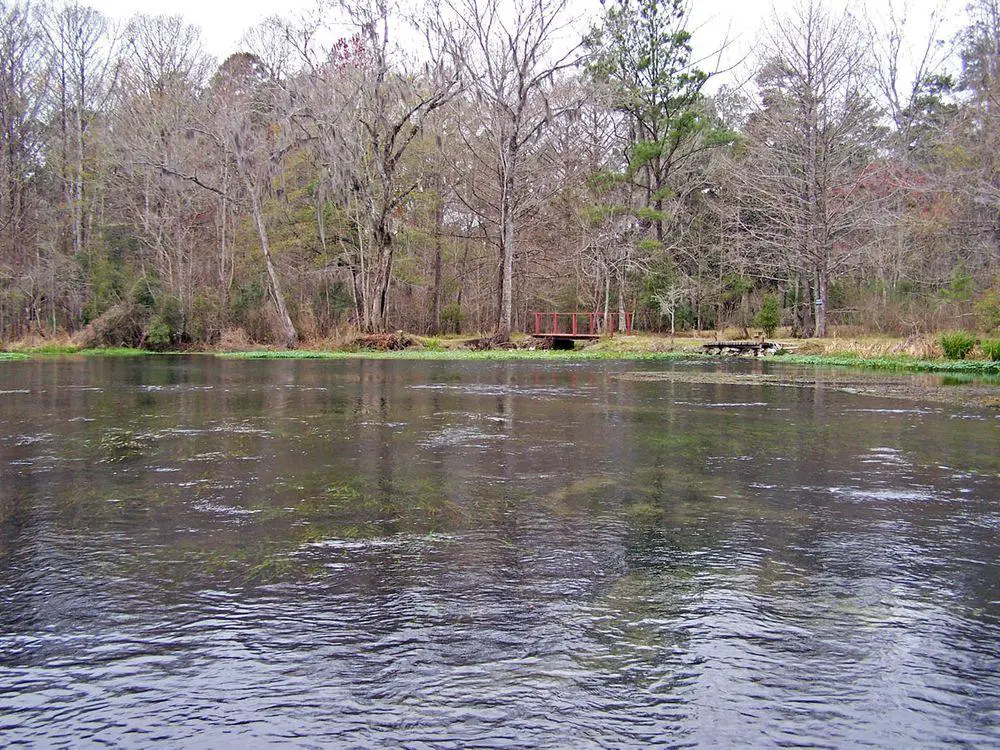
05
Nutall Rise in Aucilla River
 29.3%
29.3%
River rise
10 200 l/s (December 2001) (4.)
A resurgence of Aucilla River after a short underground segment. This is the last river rise on the Aucilla River – but there are many more upstream.
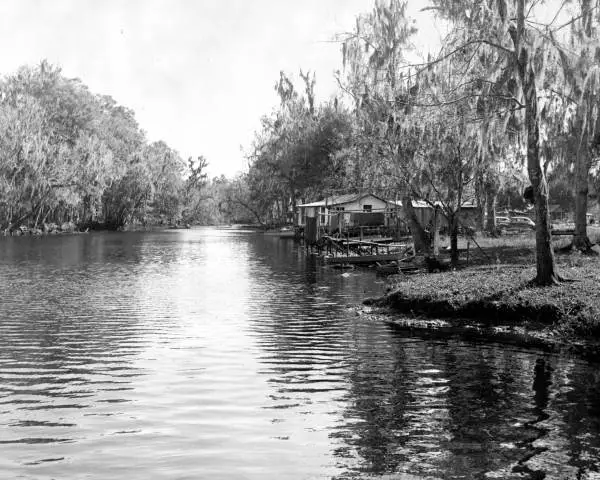
06
Steinhatchee Rise
 28.3%
28.3%
River rise
9 910 l/s (1999) (5.)
Steinhatchee River flows for some 600 meters under the ground and then resurfaces as a giant spring. This resurgence is Steinhatchee Rise.
07
Spring Creek Springs
 34.8%
34.8%
Group of subaquatic artesian springs
8,683 l/s (1996) (6.)
This is not a very clear case of first magnitude spring, because there are several powerful springs and it is very complicated to measure each of them separately. Most of the Spring Creek Springs – a group of 14 powerful springs – are below the sea level.
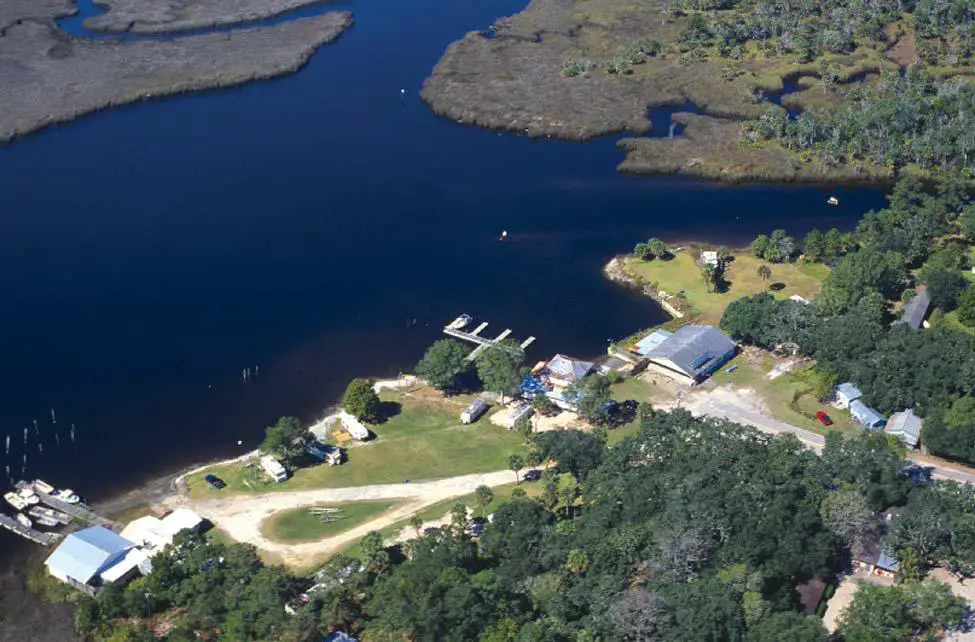
08
Silver Springs
 47.7%
47.7%
Artesian spring
8,410 l/s (2003-2007) (7.)
One of the most powerful springs with a single main vent, a well known natural monument that has been developed as a resort. It was the top attraction in Florida before Disneyland.
09
Treehouse Spring
 29.0%
29.0%
Possible river rise
7,875 l/s (1998-2023) (2.)
Treehouse Springs have two spring vents close together, each of them connected to its own large cave system. Here is measured the largest of these two vents, one of the most powerful springs in Florida. Since 2015 its mean output has been over 11,000 liters per second!
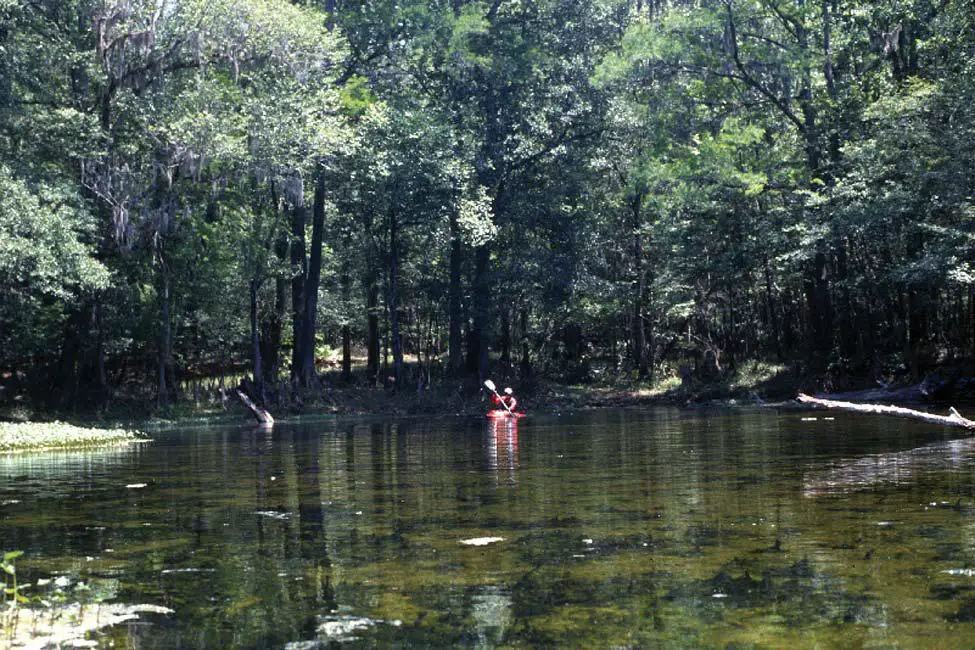
10
Holton Creek Rise
 30.0%
30.0%
River rise
6,350 l/s 1998-2023( (2.)
Holton Creek Rise is a whole river that rises from the underground. This is one of resurgences of Alapaha River.
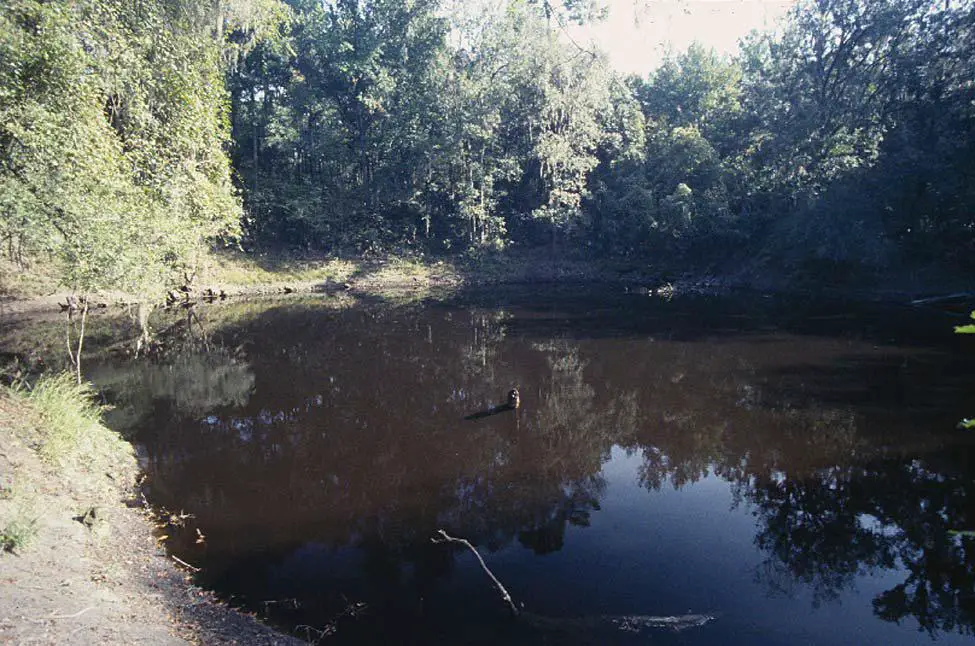
11
Devils Ear Spring (Devil’s Ear Spring)
 35.3%
35.3%
Artesian spring
5,850 l/s (2001, 4.)
A gorgeous and unusual natural landmark. This giant spring beats from the bottom of Santa Fe River from a fracture in limestone.
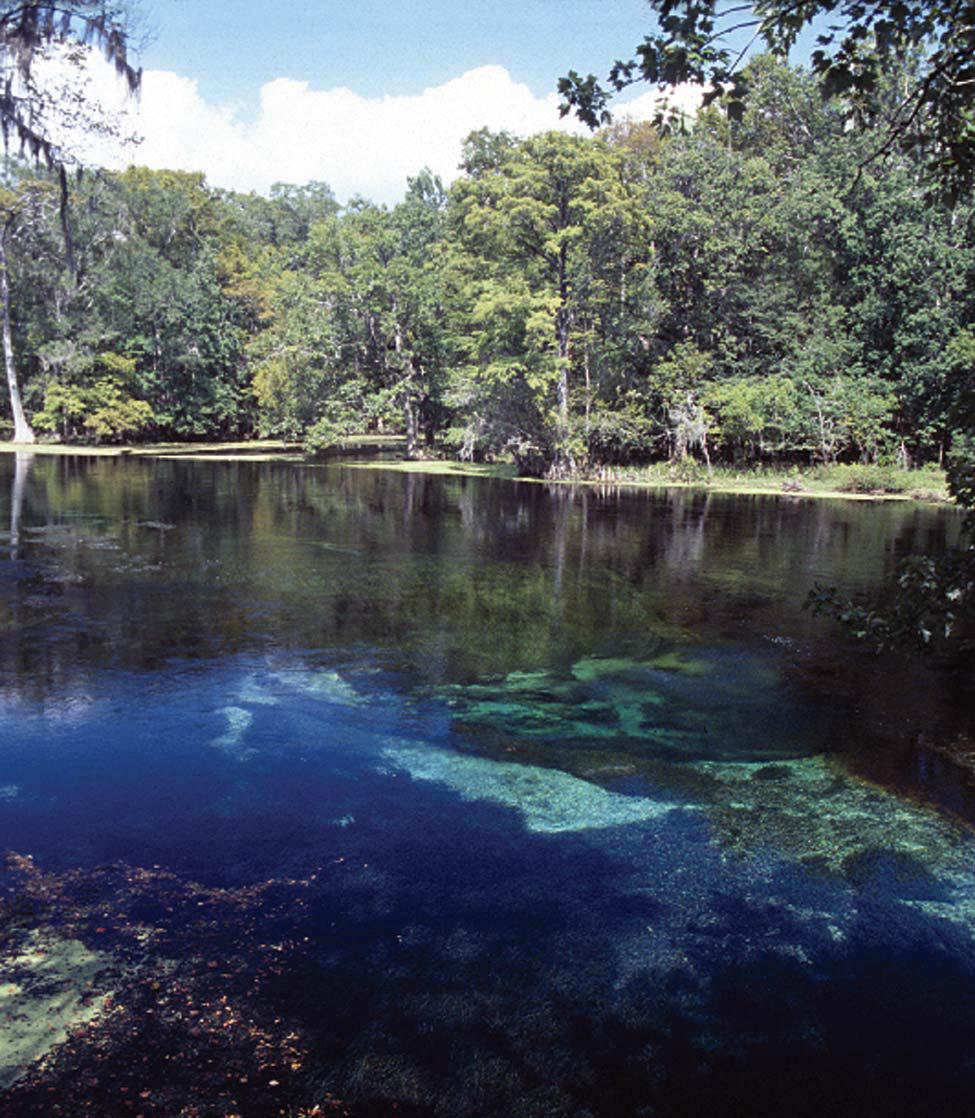
12
Lime Sink Spring
 30.0%
30.0%
Possible river rise
4,906 l/s (1995?) (8.)
This spring is the end of a giant underwater cave system. Lime Sink Spring is a very inconsistent spring: sometimes it erupts gargantuan amounts of tannic water, frequently the ravine is dry and, during the floods in the nearby Suwannee River the spring may reverse and turn into a sink: the water can flow into it.
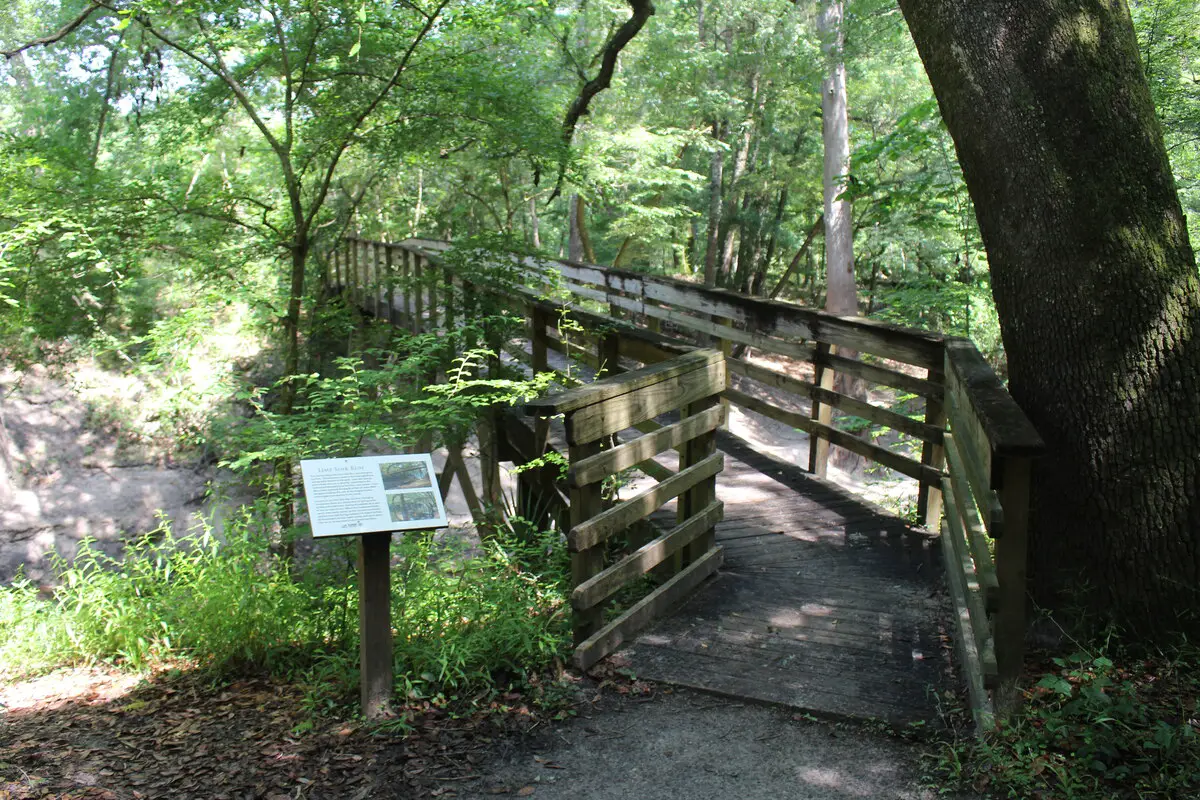
13
Rainbow Springs, 6th and 7th springs
 42.8%
42.8%
Artesian spring
4,730 l/s (middle 1990ies) (9.)
The whole system of Rainbow Springs includes at least 87 separate spring vents. This is one of the most gorgeous springs in Florida – and there is quite a a competition! The most powerful are rather closely located 6th and 7th spring vents. The data, though, is old and there is rather a high chance that springs are weaker now.
14
Weeki Wachee Springs
 40.4%
40.4%
Artesian spring
4,434 l/s (2000-2012) (10.)
Weeki Wachee Springs are famous because for more than 70 years there operates a unique underwater show of mermaids. This is a gorgeous, very powerful spring with a single vent.
15
Manatee Spring
 40.0%
40.0%
Artesian spring
4,262 l/s (Jan 2001-Sep 2023) (2.)
A gorgeous spring that serves as a refuge for manatees. One of the most visited springs in Florida.
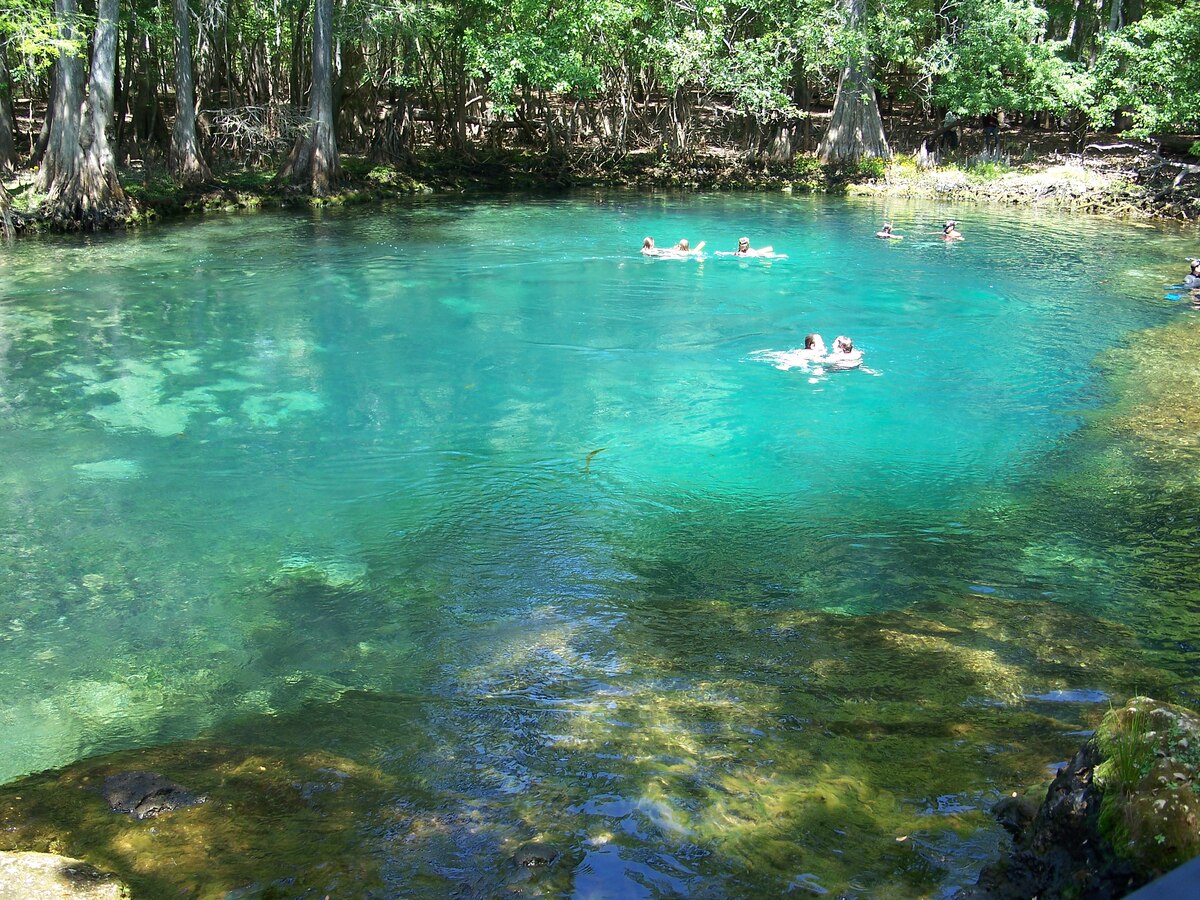
16
Volusia Blue Spring
 41.8%
41.8%
Artesian spring
3,820 l/s (2007-2017) (11.)
A gorgeous spring. The spring basin is cut with up to 38 m deep fissure and above it is seen a bulge of upcoming water. The force of the spring, though, has somewhat decreased over the last decades.
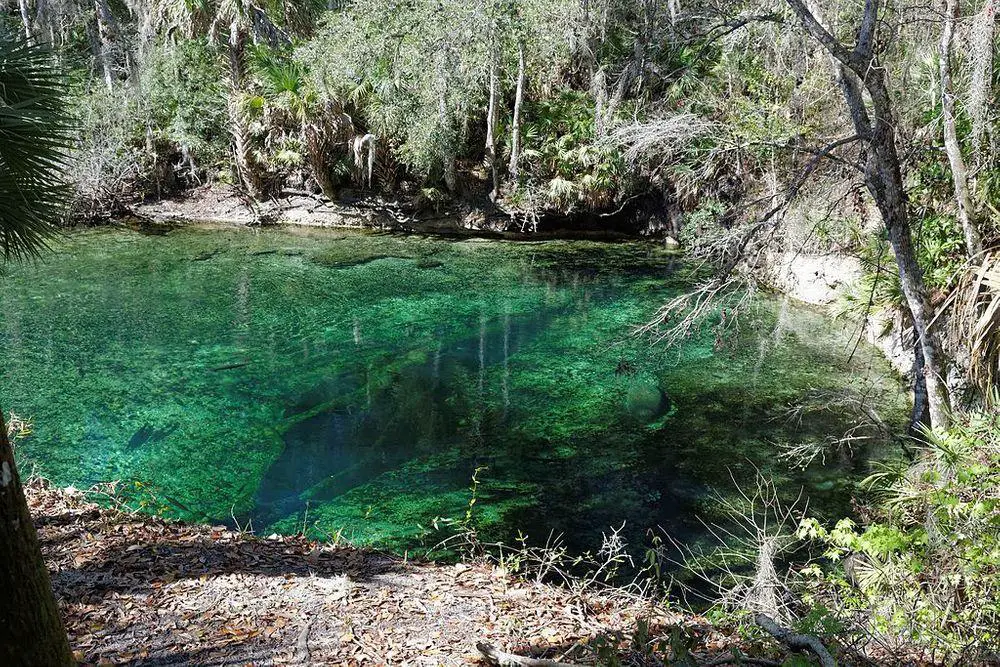
KimonBerlin, Wikimedia Commons / CC BY-SA 2.0
17
Columbia Spring (Columbia Rise)
 32.0%
32.0%
Part artesian spring, part river rise
3,819 l/s (1998 – May 2023) (2.)
One of the rare fully natural springs with a small fragment of Floridan wilderness around it. This spring seems to have a mixed source from an underground river flow and clean artesian water.
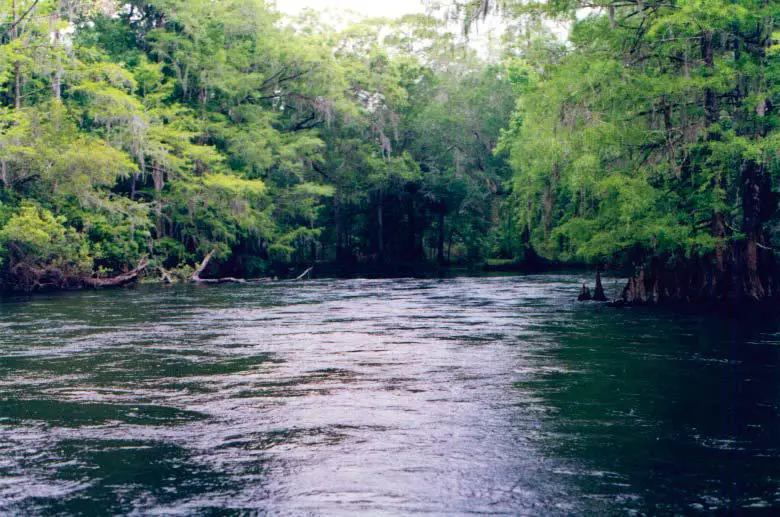
18
Rainbow Springs, 4th spring
 42.8%
42.8%
Artesian spring
3,625 l/s (middle 1990ies) (9.)
The 4th vent in the gorgeous Rainbow springs is a convincing 1st magnitude spring, it is located rather close to the giant system of 1st, 2nd and 3rd springs. Similar to other Rainbow Springs, the data, though, is old and there is rather a high chance that this spring is weaker now.
19
Siphon Creek Rise
 30.8%
30.8%
River rise
3,398 l/s (2001) (12.)
This river rise has formed in an unusual location, where Santa Fe River goes underground in a mighty siphon and rises above the ground in several river rises. Siphon Creek Rise is the most powerful of these river rises.
20
Rainbow Springs, 1st, 2nd and 3rd springs
 42.8%
42.8%
Artesian spring
3,625 l/s (middle 1990ies) (9.)
The first three vents of Rainbow Springs form a powerful 1st magnitude spring. Futher along the stream are two more 1st magnitude spring systems. Similar to other Rainbow Springs, the data, though, is old and there is rather a high chance that this spring is weaker now.
21
Troy Spring
 42.3%
42.3%
Artesian spring
3,270 l/s (March 2002-September 2015) (2.)
Troy Spring is a typical major spring of Florida with a basin of lucid artesian water. This spring, though, has interesting history, including a wreck of 19th century steamship that sunk during the Civil War.
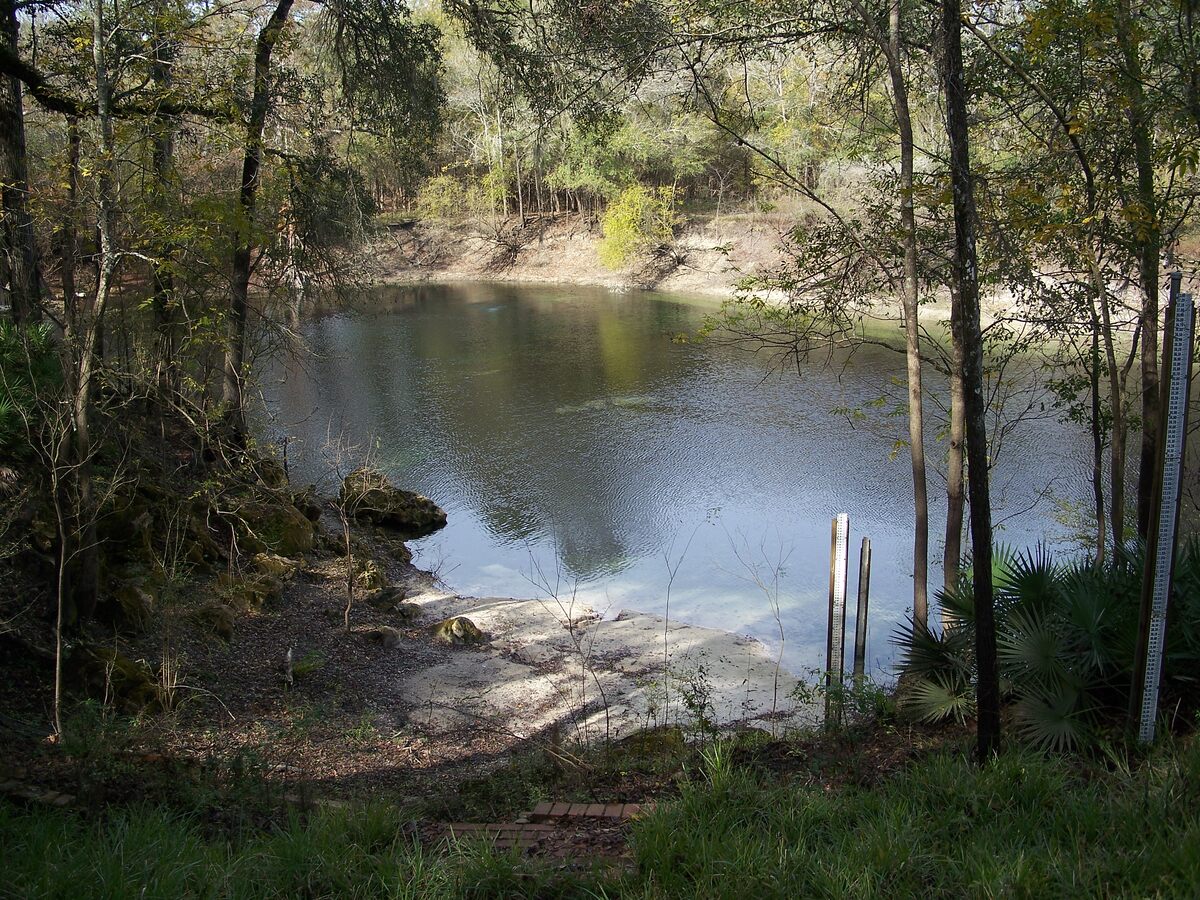
22
Chassahowitzka Main Spring
 41.8%
41.8%
Artesian spring
2,945 l/s (2001?) (13.)
The whole group of the beautiful Chassahowitzka Springs has a discharge of 4,360 l/s, but the most powerful is Chassahowitzka Main Spring. Chassahowitzka Springs form a gorgeous, 8 km long river with unbelievably clear water.
23
Alexander Spring (Alexander Springs)
 40.0%
40.0%
Artesian spring
2,908 l/s (1982-2014) (14.)
A gorgeous spring in idyllic subtropical forest. This is one of the cleanest springs in Florida, also an important archaeological site.
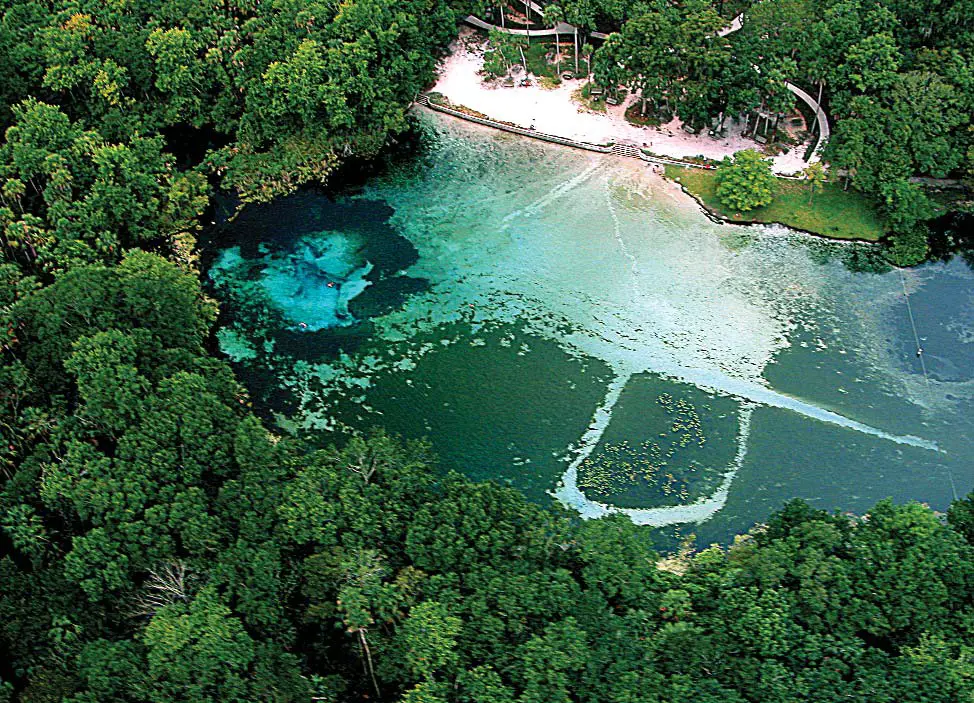
24
Crescent Beach Submarine Spring
 30.3%
30.3%
Subaquatic spring
Unknown, but very large (15.)
A very powerful freshwater (almost freshwater) spring that is unusually far from the coast – 3.9 km. Formally this is not a 1st magnitude spring, but there is little doubt that it belongs in this list.
References
- Wakulla Spring, a Plan for The Future (PDF), Florida Springs Institute. Accessed on August 27, 2023.
- Water Data Portal. Suwannee River Water Management District. Last accessed on 9th September 2023.
- Minimum Flows for the St. Marks River Rise, Northwest Florida Water Management District, 2019. Accessed on September 6, 2023.
- First Magnitude Springs of Florida, Florida Geological Survey Open File Report No 85. Accessed on October 7, 2023.
- Minimum Flows and Levels, Steinhatchee River, Florida (PDF file), Suwannee River Water Management District, May 2018. Accessed on November 13, 2022.
- Ed Lane, Spring Creek Submarine Springs Group, Wakulla County, Florida, Florida Geological Survey, Special Publication No. 47. 2001. Last visited in January 28, 2022.
- Silver Springs Near Ocala, FL – 02239500, USGS. Accessed on August 27, 2023.
- Springs of the Suwannee River Basin in Florida (PDF document), Suwannee River Water Management District, October 1998. Accessed on September 12, 2023.
- Rainbow Springs State Park, Advisory Group Draft Unit Management Plan (PDF file). Accessed on October 8, 2023.
- Nutrient TMDLs for Weeki Wachee Spring and Weeki Wachee River (WBIDs 1382B and 1382F), Florida Department of Environmental Protection, June 2014. Last visited in September 9, 2023.
- Volusia Blue Spring Restoration Plan, Executive Summary. Howard T. Odum Florida Springs Institute, May 2018. Last accessed on 14th June 2019.
- Appendix 2-2: Descriptions of Priority Springs (PDF file), Suwannee River Management District. Accessed on September 10, 2023.
- Jason S. Polk, Aurel Persoiu, Kali J. Pace-Graczyk, Underground Florida: A fieldtrip guidebook of the West Central Florida karst, January 2007. Last accessed on 10 September 2023.
- Minimums Flow Determination for Alexander Springs, Lake Country, Florida, Bureau of Resource Evaluation and Modeling St. Johns River Water Management District, Palatka, Florida, 2017. Accessed on September 9, 2023.
- Re-examining the Submarine Spring at Crescent Beach, Florida. USGS Open-File Report 00-158, July 2000. Last accessed on 9th October 2023.
25
Madison Blue Spring
 41.5%
41.5%
Artesian spring
2,763 l/s (April 2002 – September 2023) (1.)
Enchanting, gorgeous spring, voted as the best swimming hole in the whole USA. Earlier the spring was more powerful and was a 1st magnitude spring.
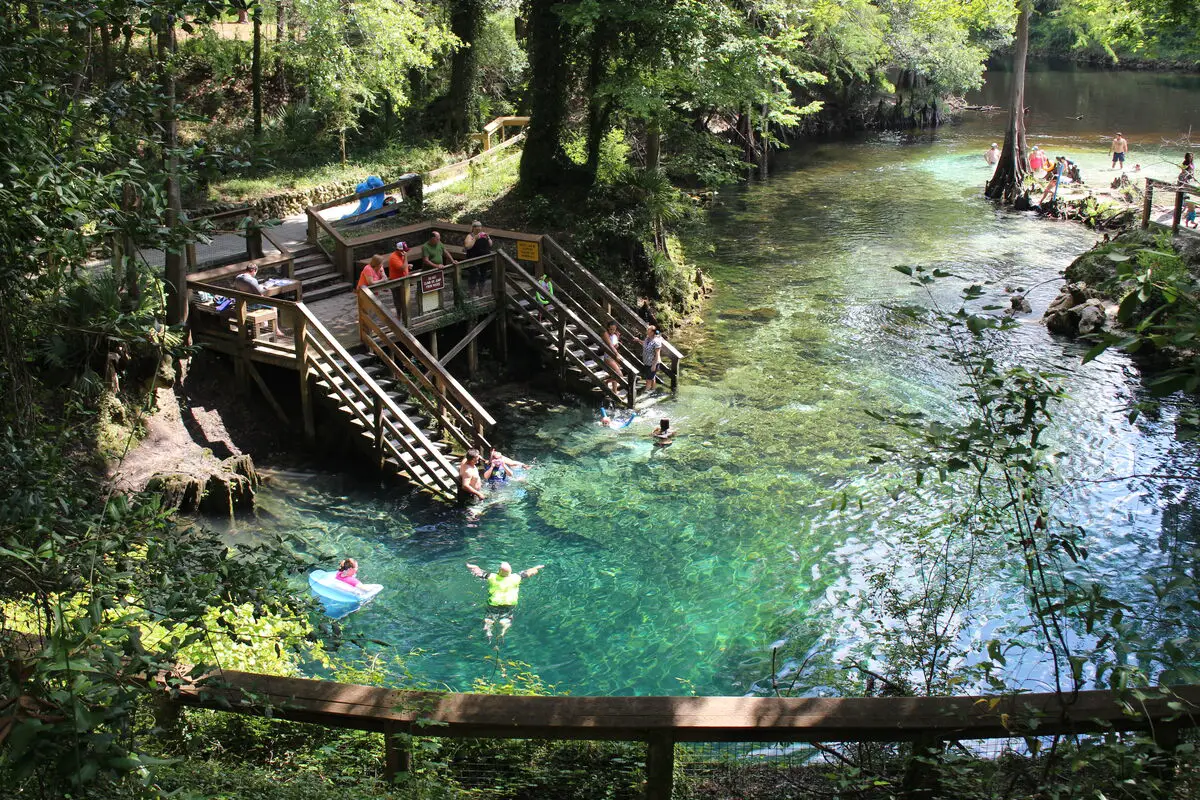
26
Hornsby Spring
 41.5%
41.5%
Artesian spring
2,755 l/s (1998 – 2023) (2.)
For some years Hornsby Spring almost stopped but since around 2015 this again is a giant spring. Most of its water descends into the Hornsby Spring Cave System soon after. Most likely, in 1-2 years this spring will be a convincing 1st magnitude spring.
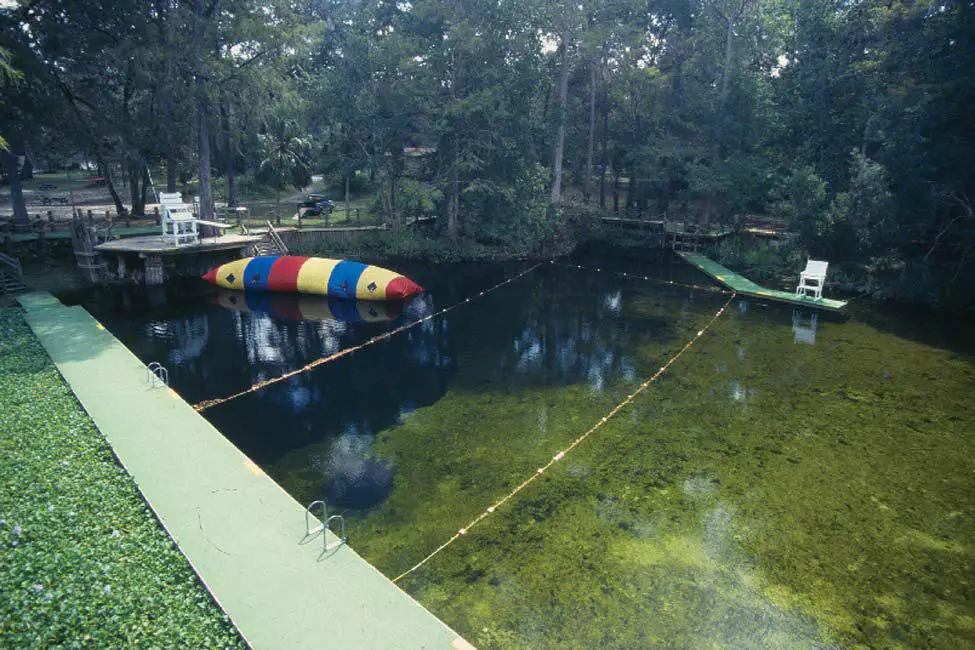
27
Blue hole Spring in Ichetucknee Springs
 35.5%
35.5%
Artesian spring
2,695 l/s (February 2002 – September 2023) (2.)
The most powerful spring in Ichetucknee Springs, and – most likely – also the most beautiful one. Even after the penetration of 11 m deep spring pool the spring discharge creates a bulge on the surface.
28
Silver Glen Springs
 38.5%
38.5%
Artesian spring
2,577 l/s (2004-2023) (4.)
One of the cleanest major springs in Florida. It has two vents (discharge is a sum of both) and, even if this is not a 1st magnitude spring, it is very powerful. A settlement was located next to the springs some 5,600 years ago and impressive shell mounds were around it earlier.
29
Lafayette Blue Spring
 34.5%
34.5%
Artesian spring
2,126 l/s (1998-2015) (2.)
This powerful spring comes from the 6,096 m long Blue Spring-Green Sink Cave System. A natural limestone bridge spans the spring pool.
30
Fanning Spring
 37.8%
37.8%
Artesian spring
1,921 l/s (2001-2023) (2.)
Earlier this spring was a convincing 1st magnitude spring, but now its output is decreasing. It is also increasingly polluted, but still a beautiful place, a popular swimming hole.
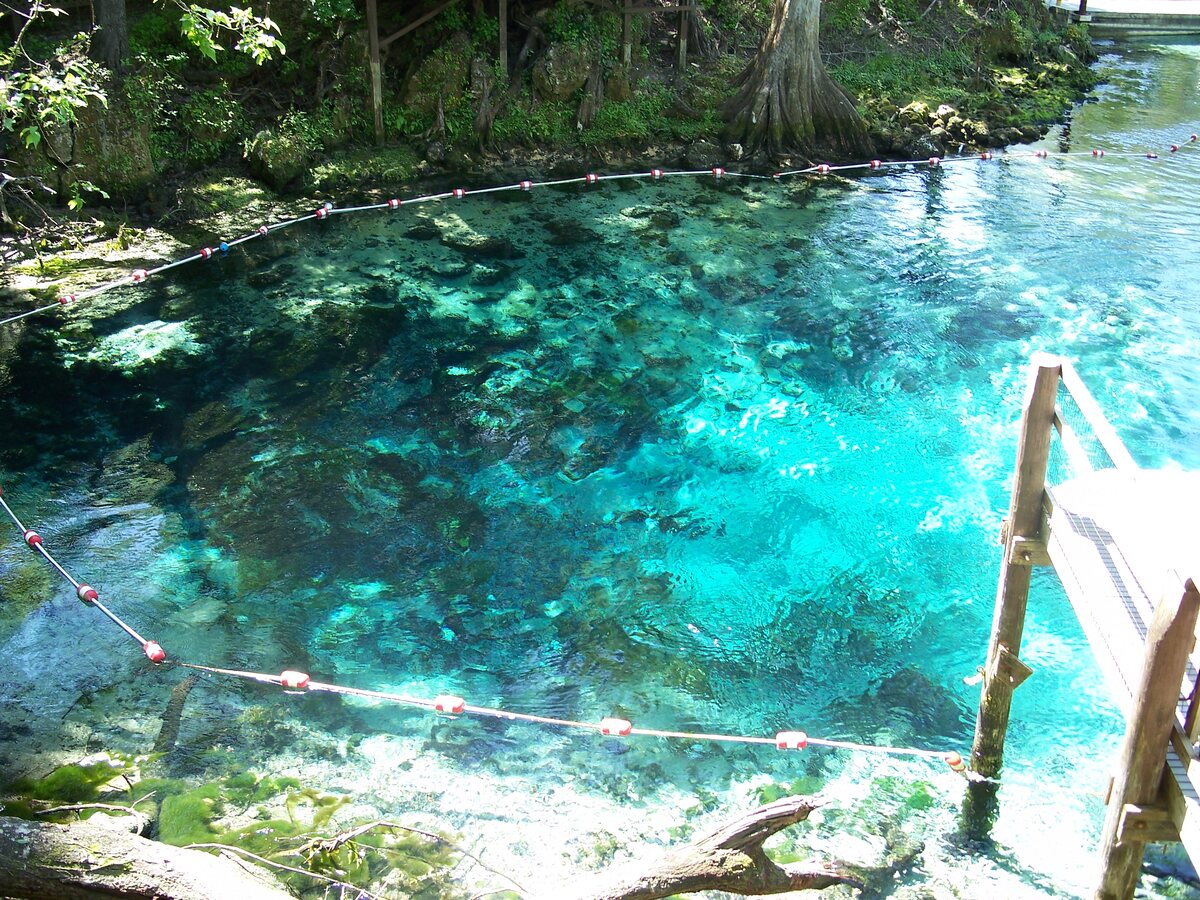
31
Santa Fe Spring
 32.5%
32.5%
Part river rise, part artesian spring
1,689 l/s (1997-2023) (2.)
This spring was more powerful earlier but now its output decreases due to the water extraction in this area. Now it even stops during the droughts and frequently its water has a tannic brown color, similar to a river water.
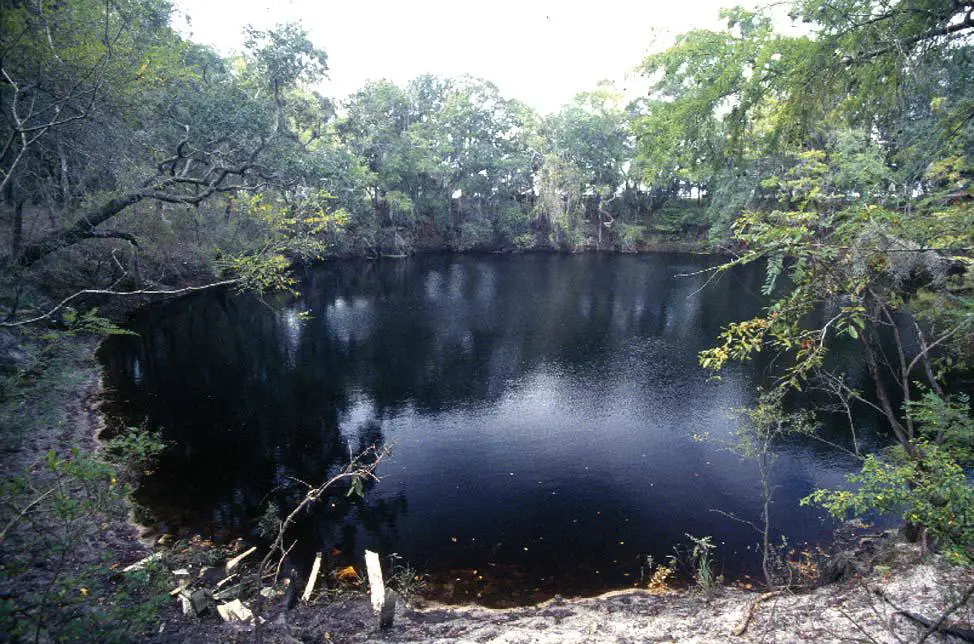
32
Falmouth Spring
 30.3%
30.3%
Karst window
1,553 l/s (1997-2023) (2.)
This is a 137 m long section of a collapsed cave with a “spring” in one end and a dangerous syphon in the other end.
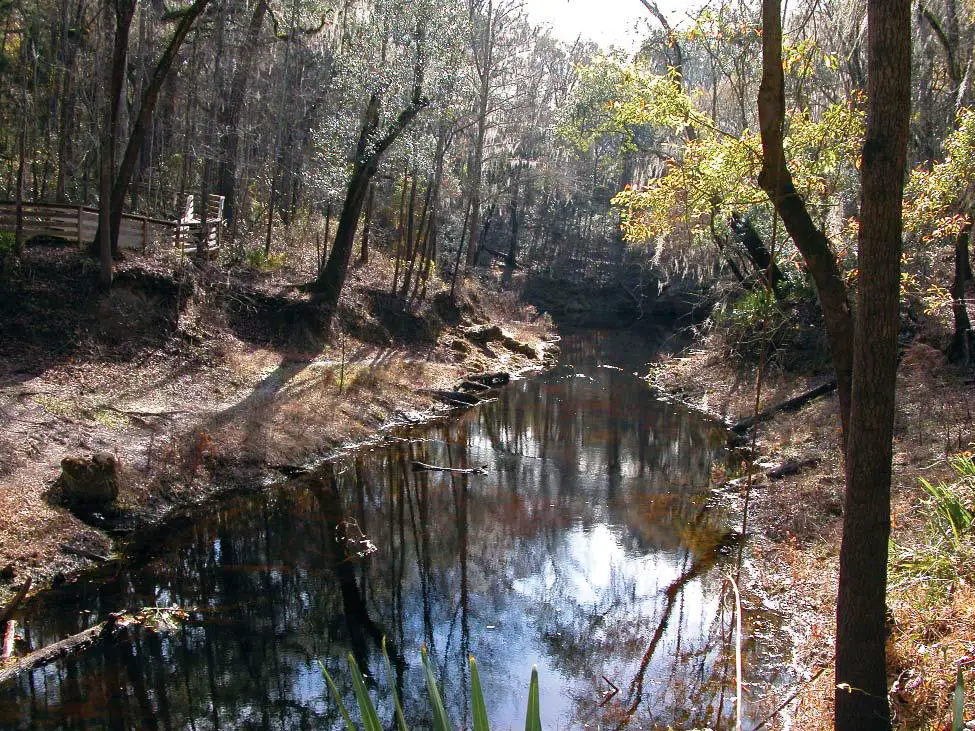
33
Jackson Blue Spring
 37.5%
37.5%
Artesian spring
1,271 l/s (2011-2023) (12.)
A beautiful spring, an entrance in an enormous underwater cave system. Former 1st magnitude spring, earlier its output was a lot higher: in 2003-2006 its mean output was 3,879 l/s. Now it is a lot weaker.
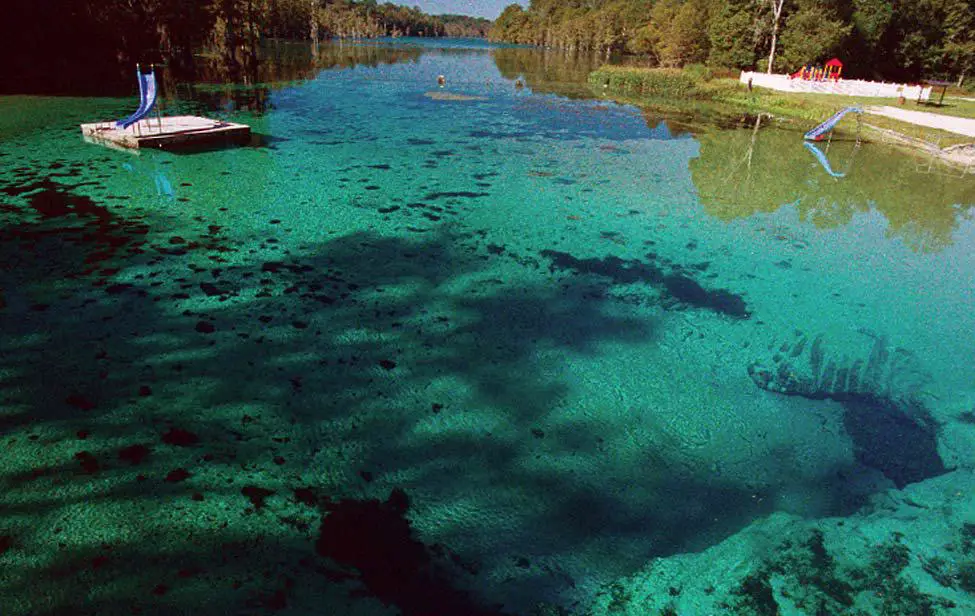
34
River Sink Spring
 28.8%
28.8%
Karst window
90 by 30 m large section of a collapsed underwater cave with a powerful flow of water in it. The measured flow of this underwater river is 4,644 l/s.
35
Upper River (Kini) Spring
 25.8%
25.8%
Karst window
A section of a collapsed underwater cave, 76 m long and 37 m wide. In 1972 the flow rate of this underground river was 4,984 l/s.
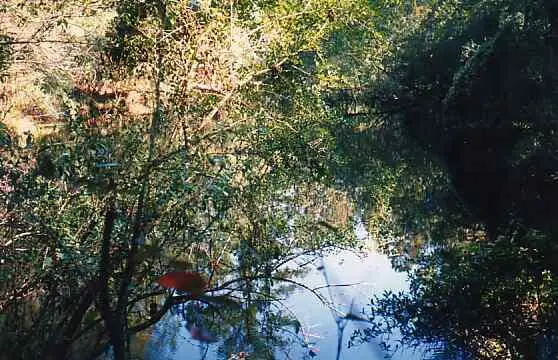
36
Natural Bridge Spring
 30.3%
30.3%
Karst window
4,191 l/s (2003-2006) (5.)
An interesting karst window – a section of a collapsed cave with underground river. It looks like a winding, 410 m long chasm.
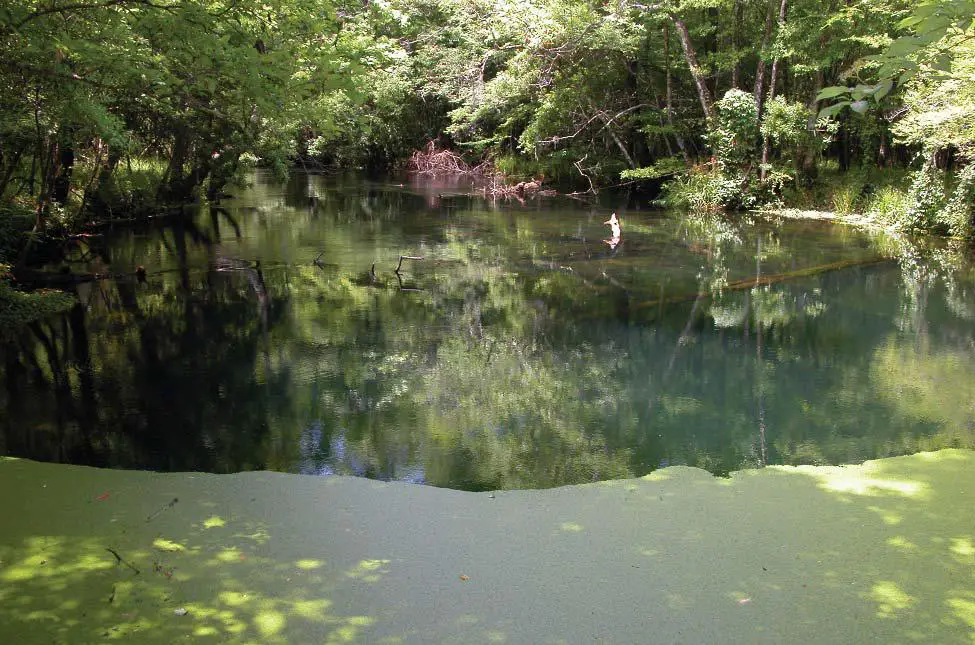
37
Homosassa Springs Group
 43.3%
43.3%
A group of artesian springs
2,492 l/s (sum of Homosassa Springs 1, 2, 3) (6.)
Headspring of the beautiful Homosassa Springs. This headspring has three vents in a 58 by 87 m large pool. In a way, these three vents could be considered to be a single spring – but it also does not reach the power of a 1st magnitude spring.
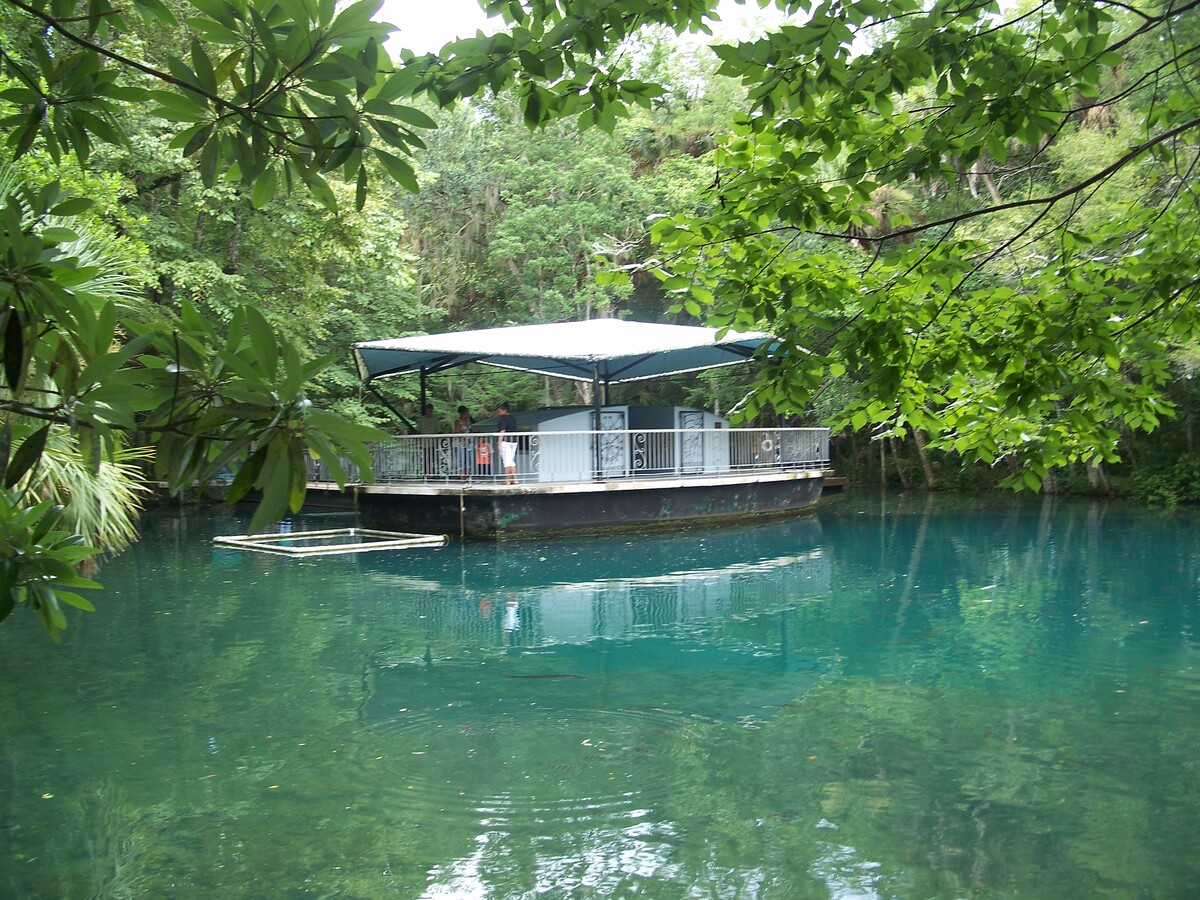
38
July Spring
 35.5%
35.5%
Artesian spring
850 l/s (2007) (2.)
A natural, beautiful spring with a pristine forest around it. In some measurements the discharge of this spring exceeded the threshold of 1st magnitude spring, but other measurements show a more modest result. One of the entrances in the 7,174 m long Devils Eye Cave System.
39
King’s Bay (Crystal River) Springs Group
 41.9%
41.9%
A group of artesian springs
25,940 l/s (major part of the group)
In the 240 ha large King’s Bay there are some 50-70 large springs, including some 12 2nd magnitude springs, such as the 1,213 l/s strong Tarpon Hole. These submarine springs flow in a shallow sea bay and are a popular wintering location for manatees.
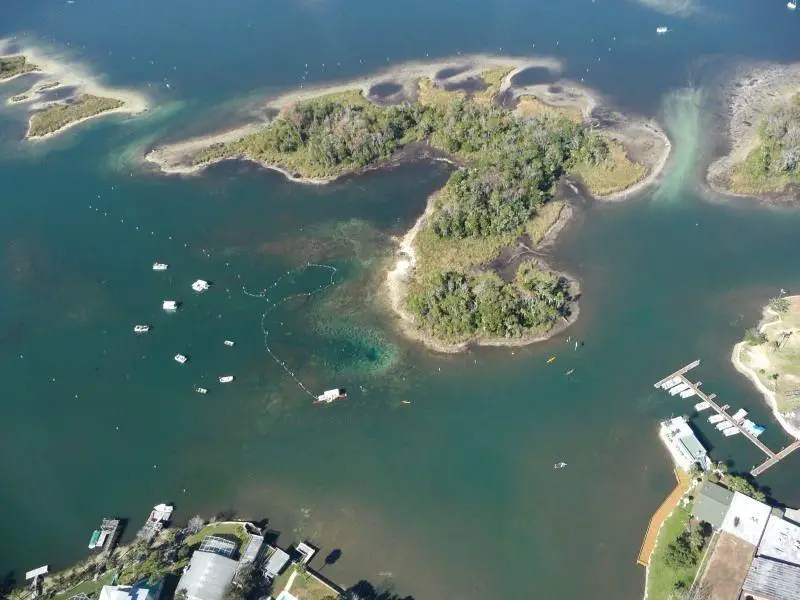
40
Wacissa Springs Group
 35.5%
35.5%
A group of artesian springs
10,987 l/s (whole group of springs)
A group of seven closely located artesian springs that forms a large river.
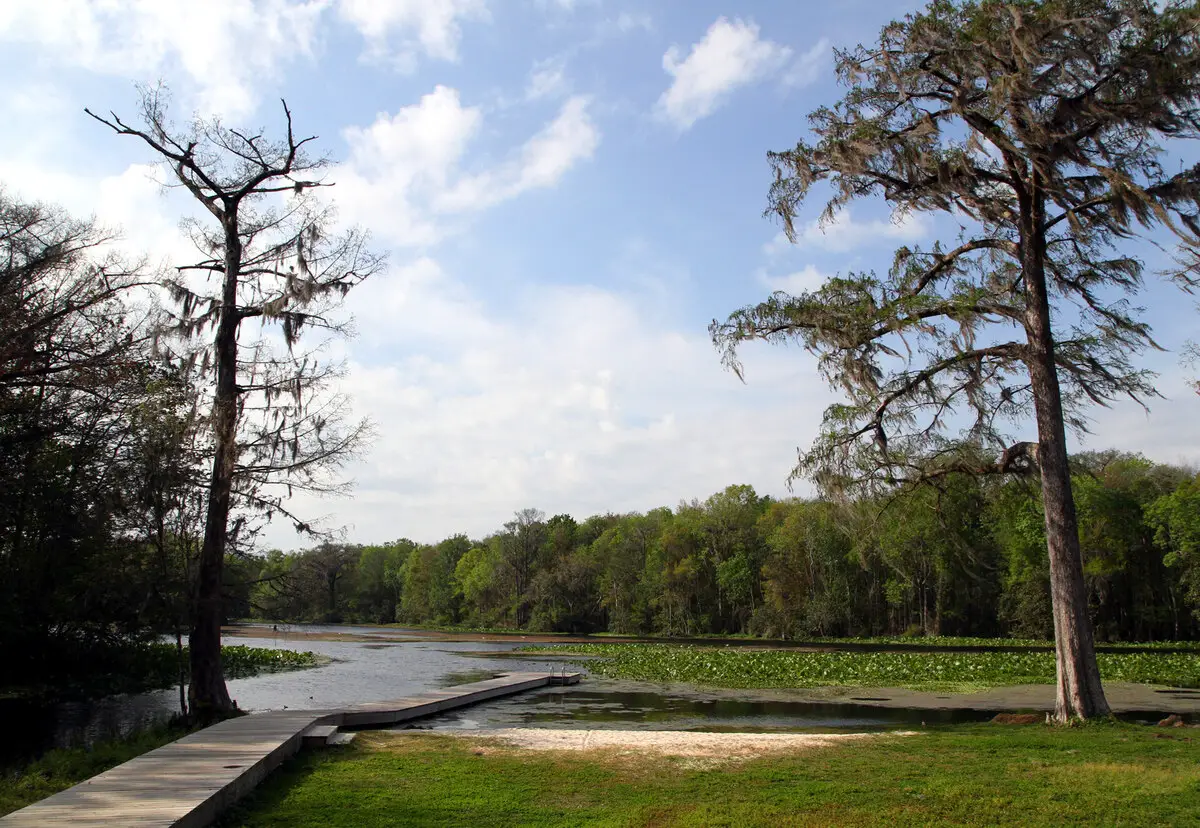
41
Gainer Springs
 41.8%
41.8%
A group of artesian springs
Around 4,500 l/s
A group of five major and eight smaller springs. This is a gorgeous natural landmark, especially Gainer Spring #3 with its eternal underwater fountain of sand and pieces of shells.
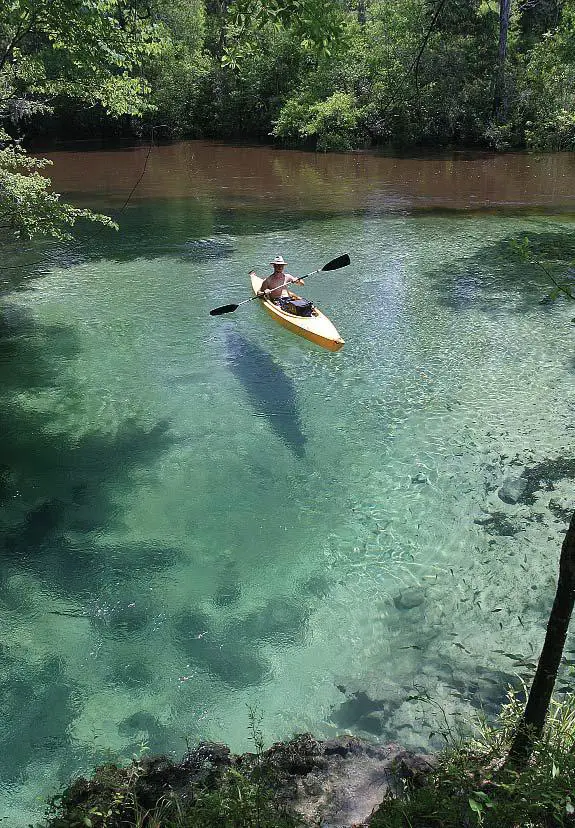
References
- Madison Blue Spring NR Blue Springs, FL – 02319302, USGS. Accessed on August 27, 2023.
- Water Data Portal. Suwannee River Water Management District. Last accessed on 9th September 2023.
- USGS 02358795 JACKSON BLUE SPRING NR MARIANNA, FL, USGS. Accessed on August 27, 2023.
- Silver Glen Springs Near Astor, FL – 02236160, USGS. Accessed on September 17, 2023.
- Kris Barrios, St. Marks River and Wakulla River Springs Inventory
Leon and Wakulla Counties, Florida, Northwest Florida Water Management District, July 2006. Accessed on September 13, 2023. - Homosassa Springs at Homosassa Springs FL – 02310678, USGS. Accessed on August 27, 2023.
 Recommended books
Recommended books
The Hikers Guide to the Hawaiian Islands
Written in the same accessible style and format as the highly successful The Hikers Guide to O‘ahu, this updated and expanded volume includes the best day hikes and backpacks on the Big Island, Kaua‘i, Maui, and O‘ahu. Each island is represented by thirteen hikes, for a total of fifty-two in all. Together they offer residents and visitors the essential information to safely explore some of Hawai‘i’s most spectacular scenery.
Hawaii Off the Beaten Path®
A series for the individual with a unique taste in travel presents easy-to-use, state-by-state, or province-by-province handbooks that describe the unusual, offbeat, and little-known places that most tourists miss, in guidebooks that come complete with maps, illustrations, and other special features.

